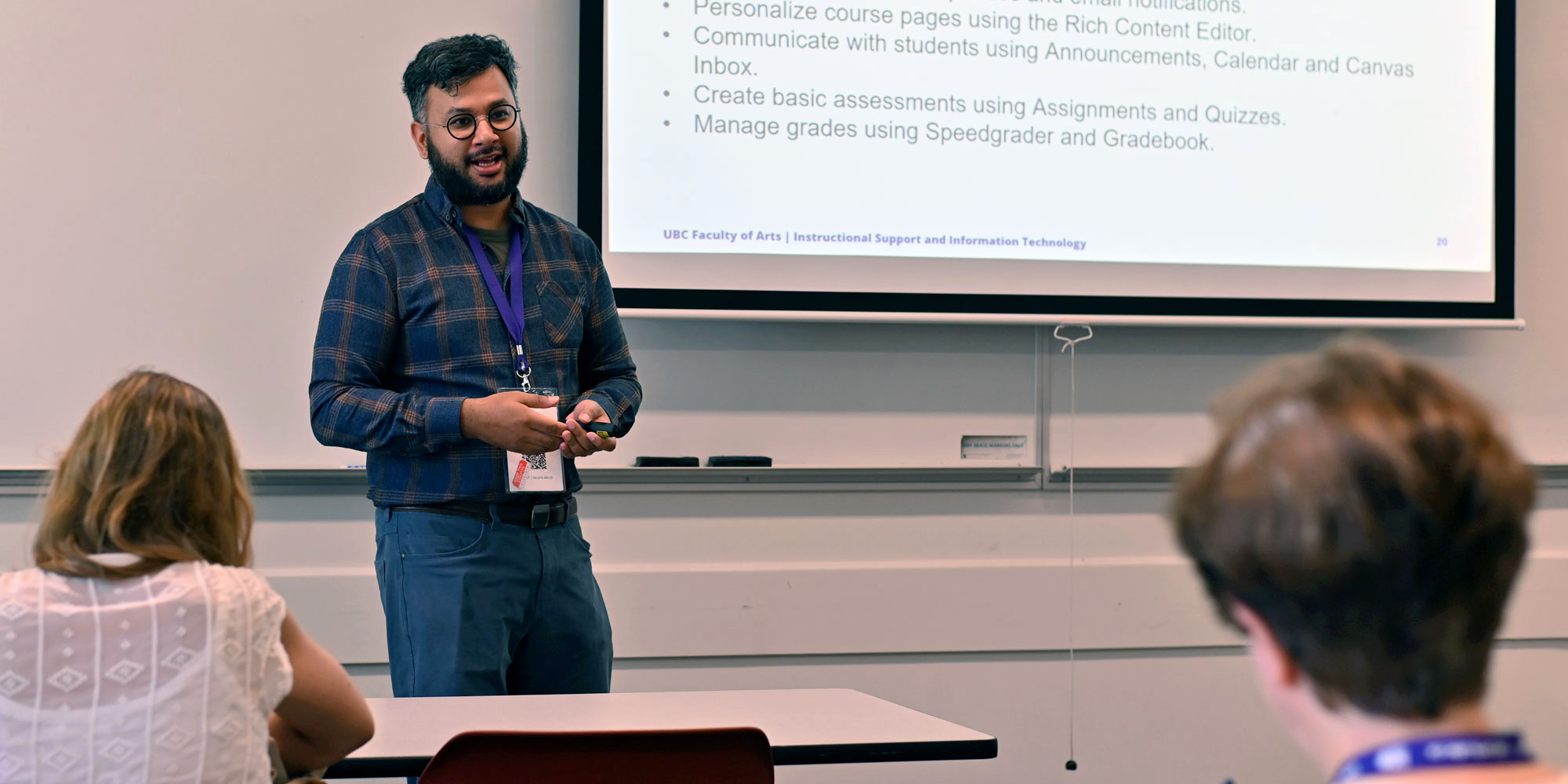

–Dr. Eric Meyers, Assistant Professor of School of Library, Archival and Information Studies
At the iSchool@UBC, we have been developing our own in-house videos to enhance teaching and learning, as well as encouraging our students to become video producers by assigning and supporting video-based course deliverables.
- E-learning with Video: A joint project of the faculty at the iSchool, the Faculty of Arts ISIT, and information institutions across the greater Vancouver area. A team of students, faculty and staff recorded and produced a series of in-house video learning objects tailored to both the formal curriculum needs of educators and broader learning needs of iSchool students, combining teaching and service to the LIS community.
- Design Literacies with Book Trailers: Initiated in 2010 with LIBR 528 (Young Adult Services), the book trailers project has continued to grow beyond the classroom. The project has been replicated and adapted by Professor Judi Saltman in LIBR 527, and expanded to the Vancouver Children’s Literature Roundtable Information Book Awards, as well as shared informally with colleagues at several institutions.
I expand on each of these project areas below. Due in part to my work on these projects, I was awarded the 2015 ALISE/ Pratt-Severn Faculty Innovation Award. You can read the announcement on our school webpage here: http://slais.ubc.ca/ischool-faculty-member-wins-innovation-award/
1) E-learning with Video
Why did we do this?
Research spanning the past decade finds that short video clips used in and outside the classroom can provide benefits for students, including increased engagement with content, new perspectives and viewpoints, contextually and emotionally resonant representations, all of which support deep learning. However, finding video that supports specific lessons and advanced topics for graduate students, even in the vast catalogue of YouTube, can be difficult. An increasingly common challenge for post-secondary institutions is the development of in-house expertise in the creation of video-based learning materials for use in face-to-face and e-learning situations.
What did we do?
Responding to this challenge, my colleagues and I at the iSchool@UBC began partnering with local information institutions to develop video-based learning objects that span classroom and practice boundaries. We initially sought to create videos that would be useful for institutions in the field as marketing and promotion pieces, while also meeting the pedagogical needs of the faculty in introductory courses. I applied for and received funding ($30,000 in two grants) from the iSchool and Arts ISIT, and Dean of the Faculty of Arts Innovation Fund, then assembled a team of faculty and students from the iSchool and the Visual Arts + Theory department at UBC, with technical support from the Faculty of Arts ISIT. We designed, produced, and disseminated over 30 instructional videos, ranging from 2-minute just-in-time tutorials to 60 minute lecture captures, launching our YouTube channel in December 2012. This project allowed the iSchool@UBC to: 1) build video production capacity within the school; 2) broaden the horizons of new students with innovative video-based learning resources; and 3) develop mutually beneficial relationships with information organizations in the community.
Examples of Collaborative Projects
Service Contexts Series: Five videos that showcase local public, special and academic libraries, allowing these institutions to tell their story. These videos were commissioned and used in LIBR 501, a core class introducing students to the information professions, to demonstrate the range of services local information institutions provide, and connect library goals to outreach and marketing. At West Vancouver Memorial Library, for example, the video illustrates the library’s digital youth programs, and the evolving nature of children’s services. WVML employed this video in the launch of their new Teen Space in 2013.
Union of BC Indian Chiefs (UBCIC) Materials Processing: A series of five video tutorials showed volunteers how to assess and process donated collections. Responding to a large donation of rare local historical materials, the Union of BC Indian Chiefs Resource Centre, a special library that focuses on local land claims, worked with our team to develop field-based, just-in-time tutorials for volunteers and interns. The series demonstrates skills from condition assessment to hinge tightening to Japanese tissue repairs. In the near future these videos will be employed in a preservation workshop for LIS students.
Indigitization Audio Preservation: Working with the Museum of Anthropology’s library and archive, the team developed video training materials to supplement face-to-face instruction on digitizing rare cultural heritage materials, specifically audiocassettes and reel-to-reel audio for language preservation. The videos will be used with a portable digitization kit initially, but will be made available to the wider community to serve as entry-level resources for widely distributed First Nations groups, and in LIS courses focused on digital preservation.
Several of these video projects, particularly the field-based documentaries, would not have been possible without the support of local information professionals. They were also outside the means of these partner institutions working alone; we received letters and emails from these partners that showed an appreciation for the high quality of our work. I argue that unique relationships between educators and practitioners can provide rich learning experiences in the classroom, practical skill development for a variety of learners, and opportunities for institutions to market their services in a new way. Uploaded to the school’s YouTube channel, these resources have been viewed nearly 30,000 times (combined) online and in a stand-alone fashion.
In addition to these collaborative endeavors, I also designed original video projects with my team that served the learning needs of our MLIS students, including:
Video Tutorial Behind-the-Scenes: We built a series of video tutorials on how to build video tutorials to support students in my own course, LIBR 535 (Instructional Role of the Librarian), and in professional field placements where they were increasingly charged with making video-based instructional materials. This video series deconstructs a benchmark tutorial assignment and provides targeted tips and tricks for using Camtasia to develop screencasts.
Online Poster Workshop: We found as our students were engaging in more research dissemination activities, they needed scaffolding in how to design research posters. I constructed a poster template and commissioned one of my video team to design a series of short videos to support customizing the template. These materials have taken the place of a face-to-face workshop, and have been used to support student conference attendance and our annual iSchool Research Day.
Results
These videos have been an important part of our school’s move toward “flexible learning”, the UBC-wide initiative that incorporates e-learning objects in and out of the classroom to improve the student experience. But I would be remiss if I did not mention the learning that occurred within the project team as well. The students who worked as my video designers, production crew, and location managers got a hands-on introduction to a unique aspect of the information professions. Two of these students chose to (successfully) pursue work in e-learning video production after graduation. I asked my first video team to make a short behind-the-scenes video to document their learning: http://youtu.be/iwBvdzW4HhM
Challenges
While the project was successful, it was not without challenges. One of the key take-aways for working with partner institutions was the need to have a project coordinator who could manage communication, permissions, consent forms, and location pre-screening, among other tasks. We also found that learning video production on the fly is not the most efficient means of developing content. On the other hand, the learning opportunities for students (and myself) were priceless.
Related Conference Presentations:
Meyers, E. M., Nathan, L. P., McGougan, A., Josten, N., Unrau, J., and Day, K. (2013). Filming the instructional story: Reflections on designing video-enhanced LIS pedagogy. Canadian Association for Information Science (CAIS’13) Conference, June 5, 2013. Victoria, BC, Canada.
Meyers, E. M. (2014). Designing a collaborative, video-enhanced LIS pedagogy. Association for Library and Information Science Education (ALISE’14) Conference, January 24, 2013. Philadelphia, PA, USA.
Hersberger, J., O’Connor, B., Meyers, E. M., Newell, B. Filmmaker showcase: Film as an information medium connecting communities and cultures. Association for Information Science and Technology (ASIS&T’14) Conference, November 3, 2014. Seattle, WA, USA.
2) Design Literacies with Book Trailers
Why did we do this?
In today’s digital world, meaning making occurs across communication modes: in text and hypertext, video and audio, and in the immersive realms of virtual worlds to name just a few. Yet, children’s and young adult services, including collection development and readers’ advisory, are still largely based in print materials: the picture book, the novel, the magazine, the informational website. The convergence of media modes and formats, demands that we prepare students in Library and Information Science (LIS) to think beyond the page, be it print or digital, both as organizers and mediators of children’s texts, but also as producers of media. Information professionals are curators and creators of content, although this second role is less often discussed and marginally supported in many LIS curricula. This project moves beyond recent articulations of “design thinking” as a prerequisite for effective LIS pedagogy, to illustrate how we might cultivate “design literacies” in our pre-service students through multimodal creative assignments.
What did we do?
Over the last four years, and in collaboration with teaching colleagues, I have developed and refined an innovative assignment involving book trailers, incorporating this sequentially into the Library Services to Young Adults and Library Services to Children courses. The goal has been to position pre-service librarians as creators, as well as support their development of design literacies. By design literacies I mean an understanding of the diverse ways that meaning is constructed through multiple media: the logics and rhetorics of media production. While book trailers are employed in the publishing industry as a marketing tool and at the K-12 level to engage young people in the development of digital skills, we rarely see this technique employed in higher education in the preparation of youth librarians and service professionals.
Samples of Student-created Trailers:
- LIBR 527: https://www.youtube.com/playlist?list=PLt-KmhRs9uSO2zhtNqKKVhdlBO-u4igZ1
- LIBR 528: https://www.youtube.com/playlist?list=PLt-KmhRs9uSMCxBLdFLveL-M1ZFjWY4o5
- VCLR Information Book Award (Aline Frederico): https://www.youtube.com/watch?v=gM45E7qI72M
The iterative, design-based approach to this project leveraged student reflections, in-class feedback, analysis of student deliverables, and written evaluations to subtly alter the pedagogy of the assignment over time to improve student products and learning outcomes.
Results
The overall success of this project has not been constrained to the classroom. In addition to providing dozens of students with a unique contribution to their MLIS portfolio, colleague Judith Saltman has connected the book trailer project with the online professional network Canadian Librarians are Serving Children (CLASC) to promote Canadian award-winning materials to a national practitioner audience. We also partnered with the Vancouver Children’s Literature Roundtable to create book trailers for the 2013 and 2014 Information Book Award. These trailers, also student produced under our guidance, help promote this book award and the shortlist of materials. These special projects have had the added effect of connecting students’ in-class experiences with professional practice, and provided another source of feedback for the creators’ videos.
Challenges
Many students have an initial reaction to making videos for class that ranges from fear to apprehension: this assignment takes many students outside their comfort zone. To overcome some of the anxiety, I worked with an MLIS student to build additional scaffolding materials, including deconstruction exercises for those unfamiliar with basic video editing. We put these materials on the web and shared them freely with others, including faculty at other LIS institutions. The links to these materials and samples of student work are found below. I am in the process of publishing these materials as an “open pedagogy”, free for any and all MLIS instructors to use under a Creative Commons license.
Related Conference Presentations:
Meyers, E. M., and Saltman, J. (2014). Teaching with book trailers: A design-based inquiry. Association for Library and Information Science Education (ALISE’14) Conference, January 24, 2014. Philadelphia, PA, USA.


